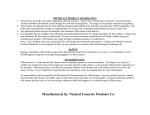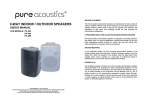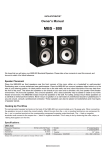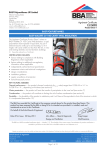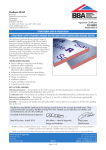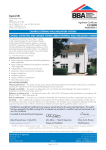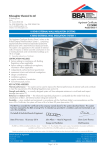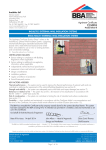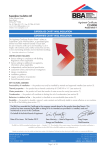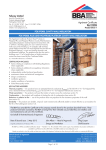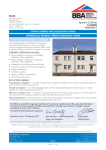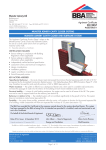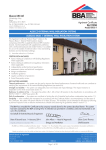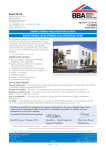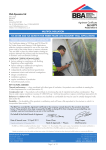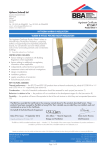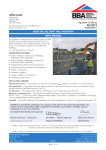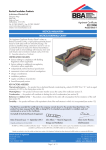Download Timloc Building Products TIMLOC CAVITY CLOSERS
Transcript
APPROVAL INSPECTION TESTING CERTIFICATION Timloc Building Products Rawcliffe Road Goole East Yorkshire DN14 6UQ Tel: 01405 765567 Fax: 01405 720479 TECHNICAL APPROVALS FOR CONSTRUCTION Agrément Certificate 07/4501 e-mail: [email protected] website: www.timloc.co.uk Product Sheet 1 TIMLOC CAVITY CLOSERS TIMLOC THERMO-LOC CAVITY CLOSERS This Agrément Certificate Product Sheet (1) relates to Timloc Thermo-loc Cavity Closers for use as a cavity closer and to form an opening in masonry cavity walls during construction. (1) Hereinafter referred to as ‘Certificate’. CERTIFICATION INCLUDES: • factors relating to compliance with Building Regulations where applicable • factors relating to additional non-regulatory information where applicable • independently verified technical specification • assessment criteria and technical investigations • design considerations • installation guidance • regular surveillance of production • formal three-yearly review. KEY FACTORS ASSESSED Hygrothermal behaviour — the products meet and exceed the minimum thermal resistance path of 0.45 m2·K·W–1, as required by the Accredited Construction Details (see section 6). Weather resistance — the products are effective as a damp-proof barrier and, when used in a suitable wall construction, will resist the passage of water into the interior of the building in flush and check reveal installations (see section 7). Structural stability — in terms of wind loading resistance, the products can be used in all areas of the UK. The products must not be used to support loads from the masonry (see section 8). Properties in relation to fire — the installed Thermo-loc Standard, Plus X, Plus C and Super Plus Cavity Closers will not contribute significantly to the growth of a fire. These products do not constitute a cavity barrier. The installed Thermo-loc FR (fire rated) Cavity Closer constitutes a cavity barrier in masonry cavity walls only (see section 9). Durability — the products, protected within the cavity, will continue to function for the normal expected life of a building (see section 11). The BBA has awarded this Certificate to the company named above for the products described herein. These products have been assessed by the BBA as being fit for their intended use provided they are installed, used and maintained as set out in this Certificate. On behalf of the British Board of Agrément Date of Second issue: 18 April 2013 John Albon — Head of Approvals Greg Cooper Originally certificated on 23 January 2008 Energy and Ventilation Chief Executive The BBA is a UKAS accredited certification body — Number 113. The schedule of the current scope of accreditation for product certification is available in pdf format via the UKAS link on the BBA website at www.bbacerts.co.uk Readers are advised to check the validity and latest issue number of this Agrément Certificate by either referring to the BBA website or contacting the BBA direct. British Board of Agrément Bucknalls Lane Watford Herts WD25 9BA ©2013 Page 1 of 9 tel: 01923 665300 fax: 01923 665301 e-mail: [email protected] website: www.bbacerts.co.uk Regulations In the opinion of the BBA, Timloc Thermo-loc Cavity Closers, if installed, used and maintained in accordance with this Certificate, will meet or contribute to meeting the relevant requirements of the following Building Regulations (the presence of a UK map indicates that the subject is related to the Building Regulations in the region or regions of the UK depicted): The Building Regulations 2010 (England and Wales) (as amended) Requirement: B3(4) Internal fire spread (structure) Comment: Requirement: C2(b) Resistance to moisture The Thermo-loc FR product can contribute to meeting this Requirement. See section 9.6 of this Certificate. Comment: The products have adequate resistance to the ingress of rain and wind driven spray and so can contribute towards a wall satisfying this Requirement. See sections 7.1 to 7.3 of this Certificate. Requirement: C2(c) Resistance to moisture Comment: The products will not constitute a significant condensation risk and so can contribute towards a wall satisfying this Requirement. See sections 6.2 and 6.3 of this Certificate. Requirement: L1(a)(i) Conservation of fuel and power Comment: The products can contribute to minimising heat loss at jambs and sills. See sections 6.1 and 6.2 of this Certificate. Regulation: 7 Materials and workmanship Comment: Regulation: 26 CO2 emission rates for new buildings The products are acceptable. See section 11 and the Installation part of this Certificate. The products can contribute to minimising heat loss at jambs and sills. See sections 6.1 and 6.2 of this Certificate. Comment: The Building (Scotland) Regulations 2004 (as amended) Regulation: 8(1) Regulation: Standard: 9 2.4 3.10 3.15 6.1(b) 6.2 7.1(a)(b) Statement of sustainability The products can contribute to meeting the relevant requirements of Regulation 9, Standards 1 to 6, and therefore will contribute to a construction meeting a bronze level of sustainability as defined in this Standard. In addition the products can contribute to a construction meeting a higher level of sustainability as defined in this Standard, with reference to clauses 7.1.4(1)(2) [Aspects 1(1)(2) and 2(1)], 7.1.6(1)(2) [Aspects 1(1)(2) and 2(1)] and 7.1.7(1)(2) [Aspect 1(1)(2)]. See section 6 of this Certificate. Comment: Regulation: Carbon dioxide emissions Building insulation envelope The products can contribute to minimising heat loss at jambs and sills, with reference to clauses 6.2.3(1), 6.2.4(1)(2) and 6.2.5(2). See section 6.1 of this Certificate. Comment: Standard: Condensation The products will not constitute a significant condensation risk and so can contribute towards a wall satisfying this Standard, with reference to clauses 3.15.1(1)(2), 3.15.4(1)(2) and 3.15.5(1)(2). See sections 6.2 and 6.3 of this Certificate. Comment: Standard: Standard: Precipitation The products have adequate resistance to the ingress of rain and wind driven spray and so can contribute towards a wall satisfying this Standard, with reference to clauses 3.10.1(1)(2) and 3.10.3(1)(2). See sections 7.1 to 7.3 of this Certificate. Comment: Standard: Building standards applicable to construction Cavities Thermo-loc FR can contribute to satisfying this Standard, with reference to clause 2.4.1(1)(2) and Annex 2.B(1) or 2.D(2). See section 9.6 of this Certificate. Comment: Standard: Fitness and durability of materials and workmanship The products can contribute to a construction satisfying this Regulation. See section 11 and the Installation part of this Certificate. Comment: 12 Building standards applicable to conversions All comments given for these products under Regulation 9, Standards 1 to 6, also apply to this Regulation, with reference to clause 0.12.1(1)(2) and Schedule 6(1)(2). Comment: (1) Technical Handbook (Domestic). (2) Technical Handbook (Non-Domestic). The Building Regulations (Northern Ireland) 2012 Regulation: 23 Fitness of materials and workmanship Comment: Regulation: 28(b) Resistance to moisture and weather Comment: The products are acceptable. See section 11 and the Installation part of this Certificate. The products have adequate resistance to the ingress of rain and wind driven spray and so can contribute towards a wall satisfying this Regulation. See sections 7.1 to 7.3 of this Certificate. Page 2 of 9 Regulation: 29 Condensation The products will not constitute a significant condensation risk and so can contribute towards a wall satisfying this Regulation. See section 6.3 of this Certificate. Comment: Regulation: 35(4) Regulation: Regulation: Internal fire spread — Structure The Thermo-loc FR Cavity Closer can contribute to satisfying this Regulation. See section 9.6 of this Certificate. Comment: 39(a)(b) 40(2) Conservation measures Target carbon dioxide emission rate The products can contribute to minimising heat loss at jambs and sills. See section 6.1 of this Certificate. Comment: Construction (Design and Management) Regulations 2007 Construction (Design and Management) Regulations (Northern Ireland) 2007 In the opinion of the BBA there is no information in this Certificate which relates to the obligations of the client, CDM co-ordinator, designer and contractors under these Regulations. Additional Information NHBC Standards 2013 NHBC accepts the use of Timloc Thermo-loc Cavity Closers, provided they are installed, used and maintained in accordance with this Certificate, in relation to NHBC Standards, Chapter 6.1 External masonry walls. Technical Specification 1 Description 1.1 Timloc Thermo-loc Cavity Closers (see Table 1 and Figure 1) are insulated, unplasticised polyvinyl chloride (PVC-U) cavity closers, available in the range listed in Table 1. They comprise a polystyrene, phenolic foam or rock fibre insulation core with a single extruded white PVC-U section fitted on one side for cavity widths up to 100 mm. Thermo-loc Plus X is also available with two smaller PVC-U sections fitted on both sides, for cavity widths above 100 mm. The PVC-U sections incorporate fixing channels. Thermo-loc Standard and Thermo-loc Plus X are available with grooves within the insulation to act as cutting guides for cavity widths up to 100 mm. See Figure 1. Table 1 Timloc Thermo-loc Cavity Closers Thermo-loc Standard Insulation Declared thermal conductivity 90/90 (W·m–1·K–1) Expanded polystyrene 0.038 Thermo-loc Plus X Extruded polystyrene 0.034 Thermo-loc Plus C Expanded polystyrene 0.038 Thermo-loc Super Plus Thermo-loc FR (fired-rated version) Phenolic foam Rock fibre mineral wool 0.027 (estimated) 0.034 1.2 The profiles are available in 2.1 m, 2.4 m and 3.0 m lengths and in widths to suit cavities of 50 mm to 300 mm. Page 3 of 9 Figure 1 Closer components 133 118 25 25 for cavity widths up to 100 mm Thermo-loc Standard, Plus X, Plus C, Super Plus and FR Thermo-loc Standard and Plus X 55 15 30.5 for cavity widths over 100 mm Thermo-loc Plus X tie corner cleat all dimensions in mm Page 4 of 9 Figure 2 Jamb and sill detail sealant sealant sealant 30 mm 30 mm Note: An additional cavity barrier is required in Scotland and Northern Ireland Figure 3 Former insulation omitted for clarity 2 Manufacture 2.1 The cavity closer unplasticised polyvinyl chloride (PVC-U) profiles are produced by conventional extrusion techniques. The insulation is fitted in the factory. 2.2 As part of the assessment and ongoing surveillance of product quality, the BBA has: • agreed with the manufacturer the quality control procedures and product testing to be undertaken • assessed and agreed the quality control operated over batches of incoming materials • monitored the production process and verified that it is in accordance with the documented process • evaluated the process for management of nonconformities • checked that equipment has been properly tested and calibrated • undertaken to carry out the above measures on a regular basis through a surveillance process, to verify that the specifications and quality control operated by the manufacturer are being maintained. 3 Delivery and site handling 3.1 The products are delivered in packs of one type. Each pack carries an instruction leaflet bearing the marketing company’s name and the BBA identification mark incorporating the number of this Certificate. 3.2 The packs should be stored flat, away from direct sunlight and excessive heat and supported along their length to prevent distortion or damage. The products should be protected from vehicular and pedestrian traffic. Assessment and Technical Investigations The following is a summary of the assessment and technical investigations carried out on Timloc Thermo-loc Cavity Closers. Page 5 of 9 Design Considerations 4 Use 4.1 Timloc Thermo-loc Cavity Closers are suitable for use in masonry walls with nominal cavity widths in the range of 50 mm to 300 mm and with window and door frames made from timber, PVC-U, aluminium or steel. The products can be used as a template, to form an opening around which a wall can be constructed and to establish the cavity width during construction. 4.2 The closers are intended for use in a flush jamb construction with the window/door frames set back 30 mm. With the small flange removed at the factory, the closer may also be used in a check reveal application. 4.3 The products provide a damp-proof barrier between the inner and outer leaves at the point of closure, act as a cavity closer without forming a thermal bridge, and avoid the need for cutting bricks and blocks. 4.4 Masonry walls into which the cavity closers are incorporated must be constructed in accordance with one or more of the following technical specifications: • BS EN 1996-1-1 : 2005, BS EN 1996-1-2 : 2005, BS EN 1996-2 : 2006 and BS EN 1996-3 : 2006, and the relevant National Annexes • the national Building Regulations: England and Wales — Approved Document A1/2, Section 1C Scotland — Mandatory Standard 1.1(1)(2) Small Buildings Guide (1) Technical Handbook (Domestic). (2) Technical Handbook (Non-Domestic). Northern Ireland — Technical Booklet D. 4.5 Proprietary window and door frame fixings, which may be recommended by the manufacturer, are outside the scope of this Certificate. 5 Practicability of installation The products are designed to be installed by a competent general builder, or a contractor, experienced with these types of products. 6 Hygrothermal behaviour 6.1 The products can contribute to maintaining continuity of thermal insulation at jambs and sills in wall openings. The path of minimum thermal resistance through the closers calculated to BRE Information Paper IP 8/08 Determining the minimum thermal resistance of cavity closers, is at least 0.45 m2·K·W–1 when used in jambs and sills with the window/door frame set-back 30 mm or more into the wall cavity (see Figure 2). Example junction details shown in Figure 2 are acceptable and the corresponding heat loss rates ( values) in BRE Information Paper IP 1/06 Assessing the effects of thermal bridging at junctions and around openings, Table 3 may be used in carbon emission calculations in Scotland and Northern Ireland. Attention must be given to the correct set-back in order to ensure compliance with these requirements. Detailed guidance on limiting heat loss and air infiltration can be found in: England and Wales — Approved Documents to Part L and, for new thermal elements to existing buildings, Accredited Construction Details (version 1.0). See also SAP 2009 Appendix K and the iSBEM User Manual for new-build Scotland — Accredited Construction Details (Scotland) Northern Ireland — Accredited Construction Details (version 1.0). 6.2 Jambs and sills incorporating these products in accordance with section 6.1 will adequately limit the risk of local surface condensation. 6.3 Under normal domestic conditions, the level of interstitial condensation associated with these products will be low and the risk of any resultant damage minimal. 6.4 Door frames installed with proprietary fixings which cannot be set-back into the wall cavity by 30 mm may require additional thermal insulation, for example insulated dry lining, to minimise excessive heat loss and the risk of excessive surface condensation. 6.5 The junctions between the wall and the front and back of the window/door frame must be effectively sealed. 7 Weather resistance 7.1 The products are effective as a vertical damp-proof barrier at jambs of window and door openings in masonry constructions, where a brick/block closer and dpc detail would normally be used. The products are also effective as a horizontal dpc at the sill or threshold. 7.2 In standard usage, in a flush jamb detail with a minimum window set-back of 30 mm, the closers are suitable for use in exposure zones 1 (sheltered), 2 (moderate) and 3 (severe) as depicted in the map contained in section 3.1 of Page 6 of 9 BRE Report (BR 262 : 2002) Thermal insulation : avoiding risks. In this application the closer may also be considered suitable for use in other locations where a conventional return brick/block closer detail with dpc has been found to provide adequate resistance to the penetration of wind-driven rain. 7.3 In a check reveal construction (see Figure 2), the modified Thermo-loc (see section 4.1) closer is suitable for use in exposure zones up to, and including, zone 4 (very severe) as depicted in the map contained in section 3.1 of BRE Report (BR 262 : 2002), which covers all exposure zones in the United Kingdom. 7.4 The closers are not recommended for use in cavities fully filled with insulation, as the flange nibs cannot be guaranteed to prevent moisture tracking from outer to inner leaf in such applications. 8 Structural stability 8.1 The products are non-loadbearing and must not be used to support loads from the masonry. Lintels are required above window and door openings. 8.2 The products will not have an adverse effect on the structural stability of brickwork or blockwork walls constructed in the conventional manner in accordance with normal good practice as defined in the Standards listed in section 4.4 of this Certificate. Use of the products does not obviate the need for conventional wall ties around the openings. 8.3 Door and window frames should be fixed to the masonry by conventional means in addition to any fixings to the closer. 9 Properties in relation to fire Thermo-loc Standard, Plus X, Plus C and Super Plus 9.1 The installed products will not contribute significantly to the growth of a fire. 9.2 The products do not constitute a cavity barrier against the penetration of smoke and flame in the context of the Building Regulations. 9.3 The use of the products is not prevented in England and Wales where generally cavity barriers are not required around openings in masonry wall construction. 9.4 In Scotland and Northern Ireland, the products are only suitable for use in conjunction with a cavity barrier meeting the performance requirements defined in: Scotland — Mandatory Standard 2.4, clause 2.4.1(1)(2) and Annex 2.B(1) or 2.D(2) (1) Technical Handbook (Domestic). (2) Technical Handbook (Non-Domestic). Northern Ireland — Technical Booklet E, Paragraph 4.38. 9.5 The use of the products does not preclude the need to provide suitable fire protection to steel lintels where this is necessary to satisfy the national Building Regulations. Thermo-loc FR (fire-rated) 9.6 Provided that the closer fits tightly in the cavity, it will act as a cavity barrier at the opening in masonry cavity walls only (with respect to the effect of fire penetrating into or out of the cavity), providing a minimum of 30 minutes fire resistance with respect to both integrity and insulation for cavity closers up to 100 mm wide. 9.7 The use of the products does not preclude the need to provide suitable fire protection to steel lintels where this is necessary to satisfy the Building Regulations. 10 Maintenance To ensure the maximum weathertightness, the silicone seal between window or door frames and masonry must be checked regularly and repairs or renewal carried out promptly. 11 Durability The products are durable when installed in accordance with this Certificate and will not suffer significant degradation since they are protected within the cavity. The products will continue to function for the normal expected life of a building. Installation 12 General 12.1 Installation of Timloc Thermo-loc Cavity Closers must be carried out in accordance with the manufacturer’s installation instructions. 12.2 A cavity barrier may be required (see section 9.2). 12.3 Reference should be made to typical installation details shown in Figure 2, when following the installation details given in section 13. The windows in this Figure are shown for information only and do not form part of this assessment. 12.4 When installing the closer, the exposed insulation should always be positioned against the inner leaf (see Figure 2). Page 7 of 9 12.5 In cutting the products to length, care should be taken to achieve clean, flat, square ends. 12.6 When installed in conjunction with the cavity closer, the back edge of the window/door frames should be set-back at least 30 mm behind the inner face of the outer leaf to meet thermal requirements (see section 6.1) whilst ensuring that the front edge of the frame remains over the outer leaf. 12.7 The junctions between the wall and the front and back of the window/door frame must be effectively sealed. 12.8 The PVC-U flange can provide an adequate key for traditional plaster finishes. However, in locations where the plaster may be subjected to repeated impact (eg at door reveals from door slamming) it is recommended that wet plaster be reinforced by hessian scrim or, preferably, replaced by dry lining. 13 Procedure 13.1 The products can be used in both first and second fix applications. 13.2 The cavity closer should be cut into required lengths, allowing the jamb section to overlap the sill section and to butt the underside of the lintel. 13.3 In first fix applications, the cavity closer should be nailed to the jamb/sill of the door or window frame (nails are outside the scope of this Certificate) and the whole assembly built in as work proceeds. Alternatively, the closer can be built in sections using the brick ties as the work proceeds, or pre-built to act as an opening former by using brace and corner forms. 13.4 For second fix applications, the cavity closer should be pushed into the open cavity after building work is complete. The compressible nature of the exposed insulation material is used to create a friction fit in the cavity. Alternatively the insulation can be trimmed to fit using a sharp knife. 13.5 Joining offcut sections should be kept to a minimum and not carried out to sill sections. Sections are joined by mitre cutting the closer profile to allow the downward cut to run away from the jamb. Insulation should be extended from the lower closer profile to allow this to slot into the upper profile to maintain a rigid section. All overlaps must be tape sealed. Technical Investigations 14 Tests Tests were carried out to determine: • shrinkage on heating of PVC-U sections • resistance of PVC-U sections to cracking in acetone. 15 Investigations 15.1 An assessment was made of: • heat loss and condensation risk in accordance with the Accredited Construction Details (version 1.0) (England and Wales and Northern Ireland) and the Accredited Construction Details (Scotland) • the practicability of the installation • weather resistance of the products when installed in accordance with the manufacturer’s instructions • fire resistance and structural stability of walls incorporating the products • durability of the components used in the construction of the products. 15.2 the manufacturing process was evaluated, including the methods for quality control, and details were obtained of the quality and composition of the materials used. Bibliography BS EN 1996-1-1 : 2005 Eurocode 6 : Design of masonry structures — General rules for reinforced and unreinforced masonry structures NA to BS EN 1996-1-1 : 2005 UK National Annex to Eurocode 6 : Design of masonry structures — General rules for reinforced and unreinforced masonry structures BS EN 1996-1-2 : 2005 Eurocode 6 : Design of masonry structures — General rules — Structural fire design NA to BS EN 1996-1-2 : 2005 UK National Annex to Eurocode 6 : Design of masonry structures — General rules — Structural fire design BS EN 1996-2 : 2006 Eurocode 6 : Design of masonry structures — Design considerations, selection of materials and execution of masonry NA to BS EN 1996-2 : 2006 UK National Annex to Eurocode 6 : Design of masonry structures — Design considerations, selection of materials and execution of masonry BS EN 1996-3 : 2006 Eurocode 6 : Design of masonry structures : Simplified calculation methods for unreinforced masonry structures NA to BS EN 1996-3 : 2006 UK National Annex to Eurocode 6 : Design of masonry structures : Simplified calculation methods for unreinforced masonry structures Page 8 of 9 BRE Information Paper IP 1/06 Assessing the effects of thermal bridging at junctions and around openings BRE Information Paper IP 8/08 Determining the minimum thermal resistance of cavity closers Conditions of Certification 16 Conditions 16.1 This Certificate: • relates only to the product/system that is named and described on the front page • is issued only to the company, firm, organisation or person named on the front page — no other company, firm, organisation or person may hold or claim that this Certificate has been issued to them • is valid only within the UK • has to be read, considered and used as a whole document — it may be misleading and will be incomplete to be selective • is copyright of the BBA • is subject to English Law. 16.2 Publications, documents, specifications, legislation, regulations, standards and the like referenced in this Certificate are those that were current and/or deemed relevant by the BBA at the date of issue or reissue of this Certificate. 16.3 This Certificate will remain valid for an unlimited period provided that the product/system and its manufacture and/or fabrication, including all related and relevant parts and processes thereof: • are maintained at or above the levels which have been assessed and found to be satisfactory by the BBA • continue to be checked as and when deemed appropriate by the BBA under arrangements that it will determine • are reviewed by the BBA as and when it considers appropriate. 16.4 The BBA has used due skill, care and diligence in preparing this Certificate, but no warranty is provided. 16.5 In issuing this Certificate, the BBA is not responsible and is excluded from any liability to any company, firm, organisation or person, for any matters arising directly or indirectly from: • the presence or absence of any patent, intellectual property or similar rights subsisting in the product/system or any other product/system • the right of the Certificate holder to manufacture, supply, install, maintain or market the product/system • actual installations of the product/system, including their nature, design, methods, performance, workmanship and maintenance • any works and constructions in which the product/system is installed, including their nature, design, methods, performance, workmanship and maintenance • any loss or damage, including personal injury, howsoever caused by the product/system, including its manufacture, supply, installation, use, maintenance and removal • any claims by the manufacturer relating to CE marking. 16.6 Any information relating to the manufacture, supply, installation, use, maintenance and removal of this product/ system which is contained or referred to in this Certificate is the minimum required to be met when the product/system is manufactured, supplied, installed, used, maintained and removed. It does not purport in any way to restate the requirements of the Health and Safety at Work etc. Act 1974, or of any other statutory, common law or other duty which may exist at the date of issue or reissue of this Certificate; nor is conformity with such information to be taken as satisfying the requirements of the 1974 Act or of any statutory, common law or other duty of care. British Board of Agrément Bucknalls Lane Watford Herts WD25 9BA ©2013 Page 9 of 9 tel: 01923 665300 fax: 01923 665301 e-mail: [email protected] website: www.bbacerts.co.uk










